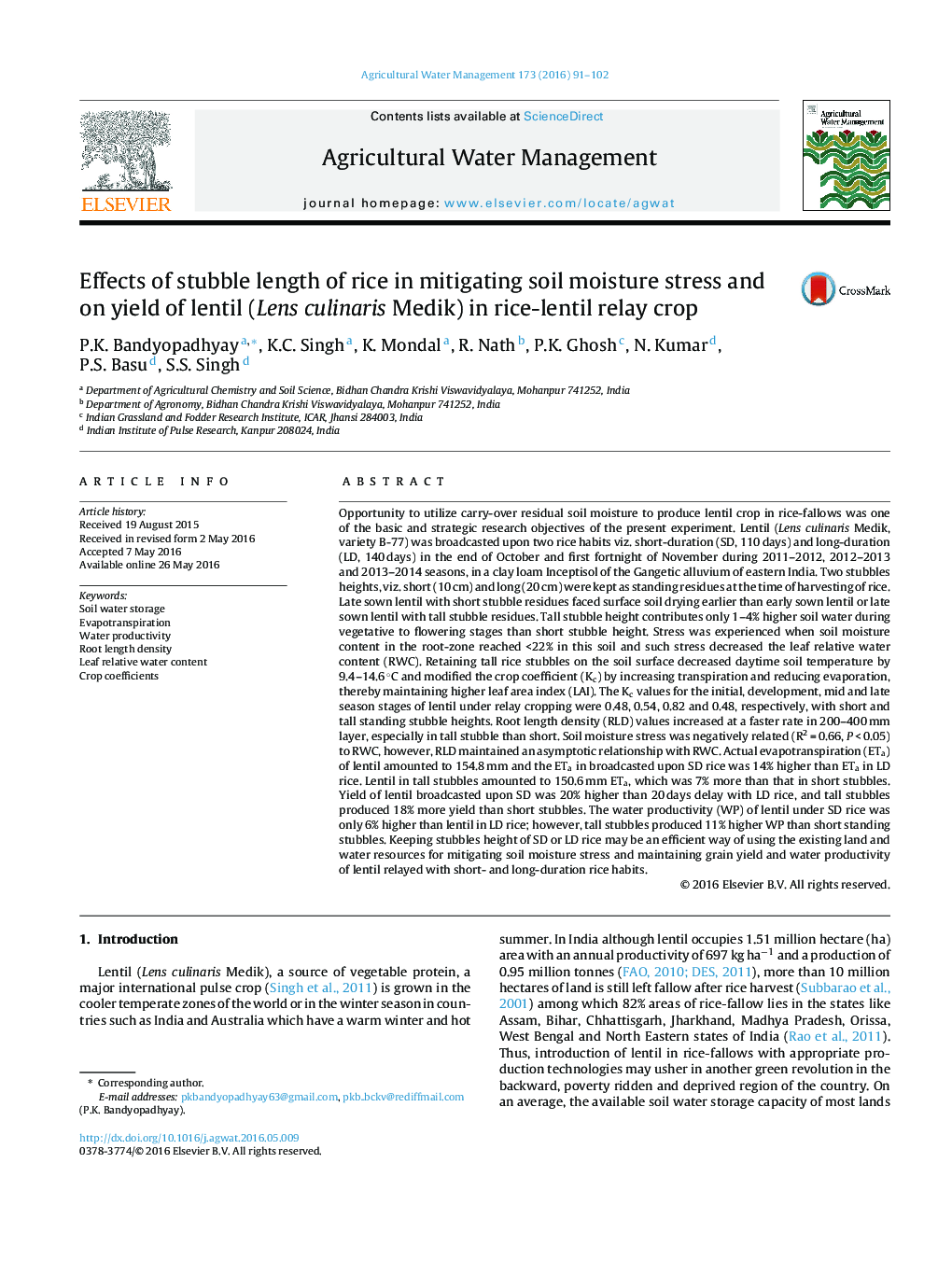| کد مقاله | کد نشریه | سال انتشار | مقاله انگلیسی | نسخه تمام متن |
|---|---|---|---|---|
| 6363470 | 1622907 | 2016 | 12 صفحه PDF | دانلود رایگان |

- Lentil was relayed with short- and long-duration (SD and LD) rice keeping stubbles.
- Relayed with LD produced 12% lower ETa and 17% lower grain yield of lentil than SD.
- Leaf RWC decreased with increasing stress had an asymptotic relationship with RLD.
- Soil water stress coefficients and crop factors were influenced by stubble heights.
- Tall stubble height, having higher WP could provide a buffer for drought periods.
Opportunity to utilize carry-over residual soil moisture to produce lentil crop in rice-fallows was one of the basic and strategic research objectives of the present experiment. Lentil (Lens culinaris Medik, variety B-77) was broadcasted upon two rice habits viz. short-duration (SD, 110 days) and long-duration (LD, 140 days) in the end of October and first fortnight of November during 2011-2012, 2012-2013 and 2013-2014 seasons, in a clay loam Inceptisol of the Gangetic alluvium of eastern India. Two stubbles heights, viz. short (10 cm) and long (20 cm) were kept as standing residues at the time of harvesting of rice. Late sown lentil with short stubble residues faced surface soil drying earlier than early sown lentil or late sown lentil with tall stubble residues. Tall stubble height contributes only 1-4% higher soil water during vegetative to flowering stages than short stubble height. Stress was experienced when soil moisture content in the root-zone reached <22% in this soil and such stress decreased the leaf relative water content (RWC). Retaining tall rice stubbles on the soil surface decreased daytime soil temperature by 9.4-14.6 °C and modified the crop coefficient (Kc) by increasing transpiration and reducing evaporation, thereby maintaining higher leaf area index (LAI). The Kc values for the initial, development, mid and late season stages of lentil under relay cropping were 0.48, 0.54, 0.82 and 0.48, respectively, with short and tall standing stubble heights. Root length density (RLD) values increased at a faster rate in 200-400 mm layer, especially in tall stubble than short. Soil moisture stress was negatively related (R2 = 0.66, P < 0.05) to RWC, however, RLD maintained an asymptotic relationship with RWC. Actual evapotranspiration (ETa) of lentil amounted to 154.8 mm and the ETa in broadcasted upon SD rice was 14% higher than ETa in LD rice. Lentil in tall stubbles amounted to 150.6 mm ETa, which was 7% more than that in short stubbles. Yield of lentil broadcasted upon SD was 20% higher than 20 days delay with LD rice, and tall stubbles produced 18% more yield than short stubbles. The water productivity (WP) of lentil under SD rice was only 6% higher than lentil in LD rice; however, tall stubbles produced 11% higher WP than short standing stubbles. Keeping stubbles height of SD or LD rice may be an efficient way of using the existing land and water resources for mitigating soil moisture stress and maintaining grain yield and water productivity of lentil relayed with short- and long-duration rice habits.
Journal: Agricultural Water Management - Volume 173, 31 July 2016, Pages 91-102